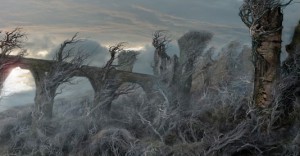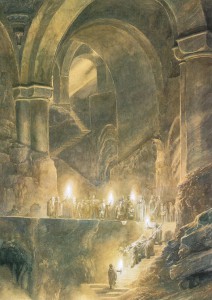Now, with the map and key in hand – Thorin and Company set off on their journey. Indeed, this journey led not only to the death of Smaug and the return of Thorin to Erebor, but also (albeit indirectly) to the finding of the Ring by Bilbo (and its passing to Frodo and ultimate destruction). All of this was contingent on Gandalf’s receiving these two small treasures from Thrain. Gimli notes this intricate fate as well:
“Did you plan all this then, Gandalf? If not, then why did you lead Thorin Oakenshield to such an unlikely door? To find the Ring and bring it far away into the West for hiding, and then to choose the Ringbearer — and to restore the Mountain Kingdom as a mere deed by the way: was not that your design?” (343)
Before Gandalf responds, it is interesting to note that he rises and “look[s] out of the window, west, seawards” (344). However, Gandalf’s response remains one of not knowing. He remembers how he once said to Frodo (it was only a year ago), “Bilbo was meant to find the Ring, and not by its maker, and you therefore were meant to bear it” (344). But Gandalf goes on: “And I might have added: and I was meant to guide you both to those points” (344).
In this way, we can see all that Gandalf did in the history of Middle-earth, pertaining to
the fate of the One Ring, as being somehow preordained. However, while I do believe that Gandalf’s finding of the map and key did, in fact, set in motion all these later events – I
do not believe that Gandalf himself designed the larger plan. Nor do I think he even knew how one event would (if at all) lead to another. This hinges on what Gandalf knew before reaching Middle-earth, when he was still Olorin in Valinor. Yet, I believe – as he says – that he “used in [his] waking mind only such means as were allowed to [him].” That is – Gandalf just reasoned his way through the problems he faced (344).
He knew Smaug was a threat. He knew something was not right in Dol Guldur. He knew the dragon could be used against them. He knew that open war would fail – and he knew Bilbo was the right hobbit to go on the journey. But how, exactly, did Gandalf know to send Bilbo? For certainly, the finding of the map and key would be for not, in the larger scheme of things, had a different hobbit been sent in Bilbo’s stead. Pippin is particularly interested in this question, and he asks Gandalf as much outright. Gandalf first replies that he would “dare say [Bilbo] was ‘chosen’ and [he] was only chosen to choose him” (345).
Regardless, the criteria by which Gandalf ended up actually choosing Bilbo are quite relevant: he wanted “a dash of the Took” and “a good foundation of the stolider sort, a Baggins perhaps.” Beyond that, Bilbo was “unattached” (Gandalf believed purposefully so, such that he was “free to go when the chance came, or he had made up his courage”) and thus the ideal candidate (345-46).
 Later, Merry questions Gandalf again about the map and key. And this is what Gandalf had to say:
Later, Merry questions Gandalf again about the map and key. And this is what Gandalf had to say:
“It was nine years after Thrain had left his people that I found him, and he had then been in the pits of Dol Guldur for five years at least. I do not know how he endured so long, nor how he had kept these things hidden through all his torments. I think that the Dark Power had desired nothing from him except the Ring only, and when he had taken that he troubled no further, but just flung the broken prisoner into the pits to rave until he died. A small oversight; but it proved fatal. Small oversights often do.” (351)
Perhaps it is now plain to see. Though Gandalf admits that he has still not told the Fellowship everything he knows – what he reveals is nonetheless great (and sufficient for this argument). The Enemy, in a spout of foolish oversight, left his prisoner unsearched in the dungeons of Dol Guldur. Gandalf then discovered Thrain and received the map and key from him. Gandalf, with these items in hand, returned to speak with Thorin Oakenshield and convinced him that a quest of stealth was the best way to defeat the dragon. However, he told Thorin that no quest would succeed without the presence of Bilbo Baggins (and Gandalf’s own support was contingent on the Dwarves’ taking the hobbit). Bilbo does depart with the Company and, because Gandalf pushes him out the door, he finds the Ring. The Company, with Bilbo in tow, is successful in both killing the dragon and reclaiming their homeland.
Bilbo, afterward, returns home with the Ring. Soon after, Frodo joins him – at which point the passing to him of this greatest of burdens is inevitable. But, in the end, Frodo destroys the Ring — all due to the choices of many wise men, the courage of friends, the strength in the bonds of fellowship – and, perhaps, to chance. But certainly, it was due to Gandalf’s finding of the map and key.



